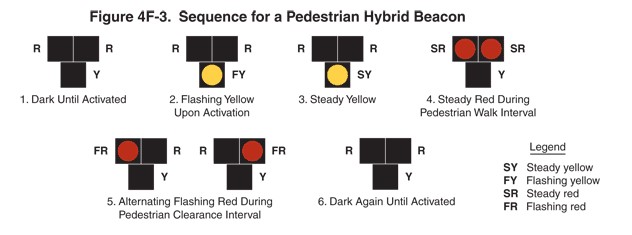Every day, pedestrians and bicyclists are faced with challenges to safely cross the street. Although the concept to cross the street is relatively simple, a wide range of solutions are available from the traffic engineering toolbox to apply the most effective option(s) at the appropriate location. As communities continue to explore solutions for improving pedestrian and bicycle safety, it’s important that they are aware of the range of solutions available to address this issue.
The traffic engineering toolbox includes a variety of safety options such as pavement markings, signage, geometric features (including traffic-calming measures such as pedestrian bump-outs and raised crosswalks), and traffic control alternatives. Transportation engineers have been challenged to use these tools, or combinations thereof, to maximize driver-yielding compliance to allow pedestrians and bicyclists to safely cross the street.
In recent years, pedestrian hybrid beacons have been added to the traffic engineering toolbox as a viable traffic control solution.
What is a pedestrian hybrid beacon?
A pedestrian hybrid beacon is also referred to as a HAWK signal (High-Intensity Activated Crosswalk) and offers significant benefits for improving driver compliance and enhancing pedestrian and bicycle safety. While many HAWK signals are often installed with a pedestrian safety focus, they have also been used to accommodate mid-block trail crossings serving bicyclists, joggers, walkers, and other non-motorized users.
How does a HAWK signal differ from other signal options?
Communities often consider installing a traditional traffic signal or Rapid Rectangular Flashing Beacon (RRFB) to accommodate pedestrian and bicycle crossings at an intersection or mid-block crossing. Many times, intersection volumes are not high enough to warrant traffic signal installation per criteria in the Manual on Uniform Traffic Control Devices (MUTCD). Traffic signals are easy to comprehend for both the driver and pedestrian/bicyclist, but they also introduce new safety issues such as rear-end crashes and red-light-running violations. Therefore, even if warrants are met, traffic signals may not create a safer environment for pedestrians and bicyclists. RRFBs are a low-cost solution to enhance pedestrian and bicycle crossing visibility, but driver compliance can be a concern if the RRFBs aren’t installed in a suitable location with the appropriate supplemental design features (pavement marking, signing, geometric features, etc.). The flashing yellow indications are not always viewed by drivers as a mandatory yield or stop condition, despite state traffic regulations.
 HAWK signals provide another viable traffic control option. The red signal indications improve driver-yielding compliance and have been shown to reduce crash severity by giving drivers advance warning of an active crossing. Pedestrians are given a clear indication when they have the right-of-way to cross with a traditional “walk” signal indication.
HAWK signals provide another viable traffic control option. The red signal indications improve driver-yielding compliance and have been shown to reduce crash severity by giving drivers advance warning of an active crossing. Pedestrians are given a clear indication when they have the right-of-way to cross with a traditional “walk” signal indication.
There are some limitations to HAWK pedestrian signal operations and understanding. Pedestrians must press a push button and wait for the signal to change before crossing, sometimes leading to impatient pedestrians crossing against the right-of-way. The signals also require drivers to understand a more complex sequence of signal indications. While not always the most appropriate solution, HAWK signals should at least be considered as a potential pedestrian and bicycle safety solution.
How does a HAWK signal work?
A HAWK signal consists of a triangular overhead traffic signal head assembly with two red indications and one yellow indication per approach, installed in conjunction with a marked crosswalk. The signal remains dark until activated by a crossing user (typically via a push button). When activated, the signal follows the following sequence of indications:
- Flashing yellow. This signal indication begins when activated by a pedestrian. This signifies changing traffic conditions and the driver should approach with caution.
- Steady yellow. When the signal changes to this indication, drivers should slow down and prepare to stop.
- Steady red. The red indications mandate drivers to stop at the crossing, per state law. During the steady red indication, pedestrians and bicyclists receive a walk indication similar to a traditional traffic signal.
- Alternating, flashing red. After the pedestrian walk time is completed, the signal changes to an alternating, flashing red. This sequence runs concurrent with the “flashing, don’t walk” indication for pedestrians. During this time, drivers may proceed after stopping when the crossing is clear.
- After the pedestrian clearance interval, the signal goes dark until the next activation.
See below for an illustration of these signal indication sequence events.

Source: 2009 MUTCD
HAWK signals have their own set of MUTCD-warranting criteria, which have lower volume thresholds compared to traditional traffic signal warrants. HAWK pedestrian signals are recommended at mid-block crossing locations with moderate-to-high pedestrian and bicycle volumes. The mid-block crossing allows approaching drivers to clearly view the signal indications and respond accordingly. While HAWK signals have been installed at intersections, MUTCD guidance considers appropriate mid-block locations at least 100 feet away from side streets under stop or yield-controlled conditions. The red indications on the HAWK signal provide positive guidance for drivers on when to stop, providing driver compliance rates of 78-82%, based on a recent study. HAWK signals offer the highest driver compliance rates of any pedestrian crossing solution other than a traditional traffic signal.
Watch below to see a HAWK signal in action at a project location in Mount Pleasant, Wisconsin:
Do HAWK signals cost more than other traffic control devices?
The estimated cost for a HAWK signal installation ranges from $80,000-$150,000, depending on the specific design elements included, such as pavement markings, lighting, raised pedestrian islands, and signage. This compares to estimated costs of $200,000 for a traditional traffic signal or $25,000 for a Rapid Rectangular Flashing Beacon (RRFB). There are several funding programs offered by the Wisconsin Department of Transportation (WisDOT), where HAWK signal installations are considered eligible improvements to improve pedestrian and bicycle safety, improve air quality, and promote non-motorized transportation modes. These programs include Congestion Mitigation and Air Quality (CMAQ), Standalone Signal and ITS Program (SSIP), Highway Safety Improvement Program (HSIP), and the Transportation Alternatives Program (TAP). WisDOT provides additional details about these programs.
We can help with your project
raSmith designed and provided construction services for a new HAWK signal installation along WIS 11 and the Pike River Pathway in the Village of Mount Pleasant, Wisconsin. The Pike River Pathway is a popular, multi-use path that extends 5.3 miles in the Village and outlying areas of Racine County. An RRFB was previously installed at this location, but driver compliance was low along WIS 11 — a four-lane, undivided roadway with a rural cross section and 40 mph posted speed limit. Construction of the HAWK signal was completed in fall 2020. Learn more about our services for this project.
raSmith has an experienced traffic engineering team that is ready to assist your community in addressing pedestrian and bicycle safety challenges. As a full-service engineering firm, we can deliver a project from the early planning stages through final construction. If you have any questions on HAWK signals or any pedestrian and bicycle safety solutions, please contact John Bruggeman, P.E., PTOE, traffic project manager, at (262) 317-3353 or john.bruggeman@rasmith.com.
